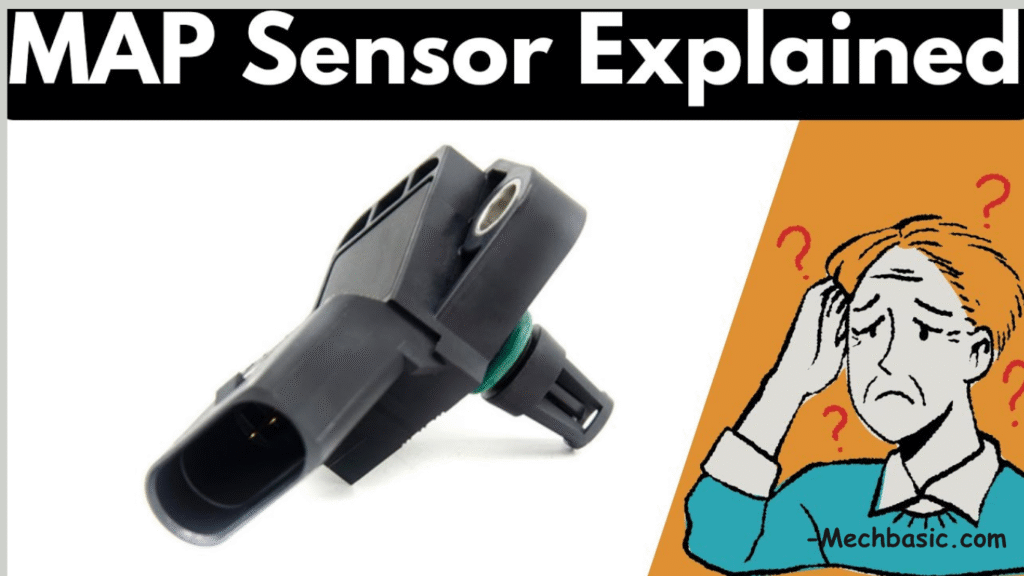Let’s go in detail about the MAP sensor in an automobile:

In this article:
1. Definition of MAP Sensor
MAP Sensor = Manifold Absolute Pressure Sensor
- It is a critical engine sensor that measures the absolute pressure inside the intake manifold of an engine.
- The intake manifold is the part of the engine where air is distributed to each cylinder.
- The sensor provides data to the Engine Control Module (ECM/ECU) to optimize fuel delivery, ignition timing, and engine performance.
2. Purpose of the MAP Sensor
- Measure Air Intake Pressure: Provides real-time pressure inside the intake manifold.
- Assist Fuel Calculation: Helps ECU determine the amount of air entering the engine to adjust fuel injection.
- Ignition Timing Adjustment: Ensures optimal spark timing for efficient combustion.
- Engine Load Detection: Higher manifold pressure = higher engine load; lower pressure = idle or light load.
- Boost Monitoring in Turbocharged Engines: Measures vacuum and boost pressure.
3. How the MAP Sensor Works
- The MAP sensor has a diaphragm that detects pressure changes in the intake manifold.
- Absolute pressure is measured relative to a perfect vacuum (0 kPa).
- The sensor converts pressure readings into an electrical voltage signal.
- Low manifold pressure (high vacuum, e.g., at idle) → low voltage
- High manifold pressure (low vacuum, e.g., under acceleration) → high voltage
- The ECU receives the voltage signal and calculates:
- Engine load
- Fuel injector pulse width
- Ignition timing
- EGR operation
4. Types of MAP Sensors
| Type | Description |
|---|---|
| Analog MAP Sensor | Outputs a continuous voltage proportional to manifold pressure |
| Digital MAP Sensor | Uses a digital signal (frequency or PWM) proportional to pressure |
| Boost MAP Sensor | Designed for turbocharged engines to measure vacuum and boost pressure |
5. Location of MAP Sensor
- Usually mounted on or near the intake manifold.
- In turbocharged engines, it may be installed before or after the turbocharger to measure boost pressure.
6. Symptoms of a Bad MAP Sensor
| Symptom | Cause / Explanation |
|---|---|
| Poor fuel economy | Incorrect air-fuel mixture |
| Engine stalling | ECU cannot calculate proper fuel delivery |
| Rough idle | Improper air-fuel ratio at low RPM |
| Hesitation during acceleration | Wrong manifold pressure signal |
| Check Engine Light (MIL) ON | ECU detects sensor fault (P0105–P0109 codes in OBD-II) |
| Increased emissions | Lean or rich air-fuel mixture |
7. Difference Between MAP Sensor and MAF Sensor
| Feature | MAP Sensor | MAF Sensor |
|---|---|---|
| Measures | Manifold pressure | Mass of airflow into the engine |
| Location | Intake manifold | Air intake pipe before throttle body |
| Function | Helps ECU calculate engine load indirectly | Direct measurement of air entering engine |
| Type of signal | Voltage proportional to pressure | Voltage or frequency proportional to airflow |
Modern engines sometimes use MAP sensor + Intake Air Temperature (IAT) sensor to calculate air mass, instead of a MAF sensor.
8. Advantages of MAP Sensor
- Simple and robust design
- Works well with turbocharged and naturally aspirated engines
- Helps ECU optimize fuel efficiency, performance, and emissions
- Less affected by dirty air intake compared to MAF sensors
✅ Summary
- MAP Sensor = Manifold Absolute Pressure Sensor
- Measures absolute pressure in intake manifold and sends a signal to ECU.
- Helps ECU calculate fuel injection, ignition timing, and engine load.
- Critical for engine performance, fuel efficiency, and emissions control.
- Symptoms of failure include rough idle, poor acceleration, stalling, and Check Engine Light.
Other courses:



